Despite being difficult to keep alive and healthy, chameleons are among the most popular reptiles in the exotic pet trade.Each year hundreds of thousands of these slow-moving reptiles are taken from the wild, both legally and illegally, many of them from threatened species living in the forests of Madagascar.Observers say the international trade in chameleons must be changed to avoid harming wild populations and improve the well-being of animals during transit and captivity.They also point to the need to make the trade fairer and more transparent, so local people can benefit from it.
DIANA REGION, Madagascar — With the sun still low in the sky, my taxi boat pulled up to a floating wooden pontoon in the bustling port of Ankify in northwestern Madagascar. As one of the few foreigners, or vazaha, in the port that morning, I was instantly surrounded by local taxi drivers eager to take me and my camera gear to the neighboring town of Ambanja.
Situated on the banks of the Sambirano River, the town is best known historically for its cocoa plantations, which supply international chocolate markets. However, in recent decades a new trade has sprung up: collecting stunning lizards with iridescent blue and green hues from the local forests. These are a much sought-after color morph of one the most popular chameleons in the exotic pet trade, the panther chameleon (Furcifer pardalis).
As my fellow photographer and translator, Michel Strogoff, and I wove through the throngs of people to the taxi, a stocky middle-aged Malagasy man blocked my path. “Caméléon! Caméléon!” he shouted in French, angrily pointing at my large, hard-bodied camera case. A heated debate in Malagasy with Strogoff made it clear that he had mistaken me for an illegal reptile dealer. Whether he was looking to settle an old score with my doppelganger or protect the local herpetofauna from a grim fate, we couldn’t decipher. But once we convinced him I was not the dealer he had in mind, he calmed down and let us on our way. That was in 2016. As an environmental filmmaker and photographer, this accusation piqued my interest, and I determined to learn more about the repercussions of the trade in Madagascar’s chameleons.
A panther chameleon (Furcifer pardalis) in a cacao plantation in Ambanja, northwestern Madagascar, where trade in the species is active. Image © Chris Scarffe Film & Photography/Michel Strogoff.
Chameleons have been part of the exotic pet trade since at least the 1800s. In recent decades, demand for the unorthodox and outlandish has exploded. Chameleons, with their ability to independently move their turret-like eyes, snipe at prey with their long tongues, and change the color of their skin, certainly qualify as unusual. Consequently, they are among the most popular reptiles with hobbyists.
Each year, it’s estimated that hundreds of thousands of these slow-moving reptiles are taken from the wild, both legally and illegally, destined predominantly for households in North America, Europe and East Asia. The true number of wild chameleons captured for the pet trade is difficult to quantify and subject to debate.
What is not in doubt is that many chameleon populations are under severe threat, and none more so than in the biodiversity hotspot of Madagascar. The country is home to more chameleon species than any other: 96 of the 217 known to exist worldwide. Of those, all are endemic to Madagascar and more than half are categorized as threatened or near threatened with extinction. Experts say the pet trade, and the thriving illegal trade in particular, is putting them at greater risk.
“The two main threats to chameleons in Madagascar are habitat loss and … the international pet trade,” said Christopher Anderson, a herpetologist at the University of South Dakota who chairs the IUCN’s Chameleon Specialist Group. In a country regularly listed among the poorest and most corrupt in the world, some people are willing to risk arrest, breaking international and national laws, to illegally harvest chameleons to supply this trade.
Guide by day, wildlife trader by night
“Jean” was born and grew up on the island of Nosy Be in northwest Madagascar, in a village close to Lokobe National Park. The dense forest of the reserve is home to a host of beguiling animals, including lemurs, geckos and chameleons. Jean has worked as a wildlife guide in the reserve for more than 10 years, and he guided me when I first visited Lokobe in 2016. Since then, I’ve always tried to hire him when I visit, as he has the keenest of eyes for spotting the incredibly camouflaged animals I’m keen to photograph.
I had heard rumors of animals being taken from the park to supply the bushmeat and pet trades. Deep in the forest, away from prying eyes and ears and relying on the trust Strogoff and I had built up with Jean, I questioned him confidentially about the topic. In such a small, close-knit community where little goes unnoticed, I thought Jean would likely know some of those involved. To my surprise, Jean said not only that he knew about the trade, but that he was occasionally involved. He was understandably reluctant to divulge any more details, fearing arrest or reprisals, and agreed to do so only on assurance of anonymity.
With his wiry frame perched on a log, shaded by the thick canopy of the forest, he told us how it all began.
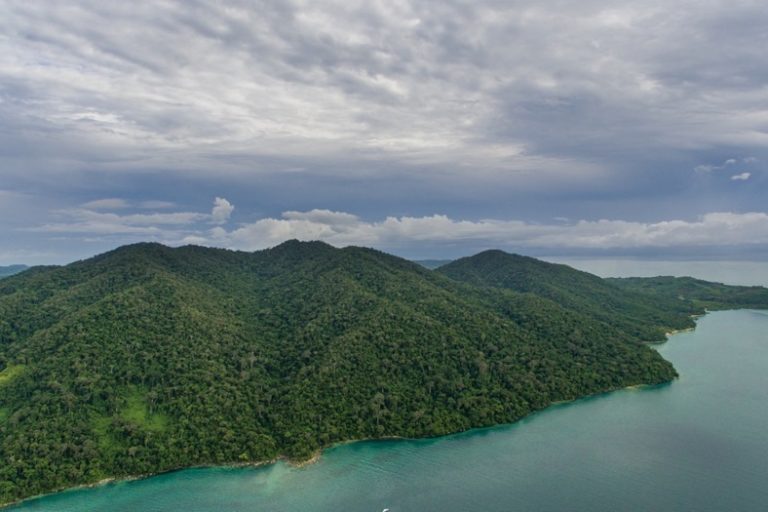 An aerial view of Lokobe National Park in northwestern Madagascar. Image © Chris Scarffe Film & Photography/Chris Scarffe.
An aerial view of Lokobe National Park in northwestern Madagascar. Image © Chris Scarffe Film & Photography/Chris Scarffe.
In 2014, two foreign men, one Chinese and the other English-speaking, visited the village accompanied by a Malagasy man from the capital, Antananarivo.
“We started chatting and they invited us for a few drinks and we started to talk business,” Jean said, describing an encounter that included three trusted friends from the village. “During this meeting they told us they wanted to buy 200 panther chameleons. We agreed on a price of 10,000 ariary [$2.50] per chameleon. So I and three other friends went out into the forest, mostly at night but sometimes also during the day, to find them.”
Panther chameleons are prized among hobbyists for their stunning color forms, like the one from Ambanja. They sell for between $150 and $600 each in the U.S. — up to 240 times what Jean typically earns.
He claims, however, that he only collects chameleons when opportunity knocks and he needs the money. “I know what I do is illegal and wrong but poverty can drive you to do things you don’t want to do,” he said. “When I have enough of my regular work I don’t need to collect animals as I can live my life and feed my family.”
Collecting wildlife inside a national park is unquestionably illegal. But Jean said that although he sometimes worries he’ll be arrested, the likelihood is low given the park’s remoteness and rare appearances by police.
Other residents of Jean’s village, also speaking on condition of anonymity, corroborated what he had told us, including that people collect chameleons only when there is sporadic demand. Some admitted to more frequently collecting other animals for the pet trade, including frogs and snakes.
Jean shrugged off the impact of this illicit trade in Lokobe. “I don’t think collecting the chameleons makes a big difference. We still see lots of chameleons and they produce so many babies.” But before parting ways he looked back at us and paused before qualifying his last statement. “Of course if there were many other people collecting chameleons regularly then their numbers would decrease. I don’t think they will disappear completely but their numbers will become very low.”
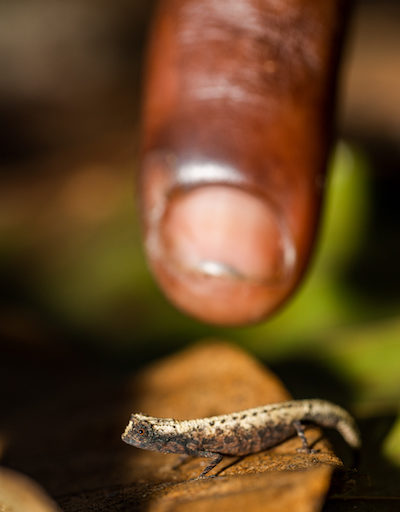 A guide points out the world’s second-smallest chameleon, the minute leaf chameleon (Brookesia minima), an endangered species, in Lokobe National Park in northwestern Madagascar. Image © Chris Scarffe Film & Photography/Michel Strogoff.
A guide points out the world’s second-smallest chameleon, the minute leaf chameleon (Brookesia minima), an endangered species, in Lokobe National Park in northwestern Madagascar. Image © Chris Scarffe Film & Photography/Michel Strogoff.
Lokobe is not the only park in Madagascar where guides are pressured to procure chameleons for overseas markets. “I have had requests from all over the world to supply the pet trade,” Patrick Andriamihaja told me with a wry smile. “Some of them have pet shops in their home country.”
Andriamihaja, a Malagasy national, knows many of these prospective buyers through his tour company, which he said caters to “herpetology geeks and obsessives” like himself. Despite this shared passion, he said he is unwilling to become involved: “Some of them have offered me more money than I ever thought I could make in my lifetime, but I am not interested in this.” Part of the reason is undoubtedly his love of nature and desire to see chameleons in the wild, but another is pragmatism. “I tell them that I won’t do this as this will destroy my job as a tour guide, as they will want to order more and more and more and this can impact on wild populations,” he said.
Foreigners also help themselves to Madagascar’s chameleons. Multiple guides told me about “researchers” from Japan, China and Europe who they believed have been illegally collecting rare species from national reserves to smuggle back to their home countries.
 The Parson’s chameleon (Calumma parsonii) is the largest and one of the most sought-after chameleons in the pet trade. Image © Chris Scarffe Film & Photography/Chris Scarffe.
The Parson’s chameleon (Calumma parsonii) is the largest and one of the most sought-after chameleons in the pet trade. Image © Chris Scarffe Film & Photography/Chris Scarffe.
The legal vs. the illegal trade
The collection of chameleons from the wilds of Madagascar to supply the international pet trade started long before Jean’s first foray in 2014. CITES export data show that Madagascar first became heavily involved in the trade in the late 1980s. By the 1990s it was one of the world’s most prolific exporters of chameleons. Commerce was both legal, as shown by CITES data, and illegal, according to Petr Necas, an independent chameleon researcher, breeder and former seller currently based in Tanzania who has been studying the trade for more than 30 years. Necas is listed as the scientific supervisor for Bion Terrarium Center, a breeder and international dealer of reptiles based in Kyiv, Ukraine.
“In Madagascar in the 1990s it was like a Klondike in terms of the numbers of illegal collectors rushing to supply the booming pet trade in chameleons,” Necas said.
The clandestine nature of this illicit trade makes it hard to accurately quantify the number of chameleons involved. Studies of other reptiles exported from other countries indicate an illegal trade between 10 and 100 times the volume of the legal trade. When I asked Necas his thoughts he gave a similar approximation for Madagascar’s chameleons. “Multiply the official export numbers by 10 for rare chameleon species and by 100 for more common species,” he said, and “you will land somewhere near the truth.”
 A blue-nosed Chameleon (Calumma boettgeri) in secondary forest on the island of Nosy Komba in northwestern Madagascar. Image © Chris Scarffe Film & Photography/Chris Scarffe.
A blue-nosed Chameleon (Calumma boettgeri) in secondary forest on the island of Nosy Komba in northwestern Madagascar. Image © Chris Scarffe Film & Photography/Chris Scarffe.
CITES export figures show Madagascar legally exported almost 66,000 chameleons a year at its peak in 1998. If Necas’s assessment of the scale of the illegal trade is correct, that would mean that at its height hundreds of thousands or possibly even millions of chameleons were being smuggled out of Madagascar per year. The latest available CITES export figures for Madagascar are for 2018, and show a marked drop-off in legal exports from the late ’90s heyday, at just over 14,500 individuals. Given the threats to chameleons, even these lower legal and projected illegal numbers could have a detrimental effect, according to some experts.
Chameleon researcher Anderson, who also keeps and breeds the animals as a hobby, told me he was reluctant to apply these projections across the board to all of Madagascar’s chameleon species, given his own observations of the numbers of animals appearing in the trade. However, he said the figures were likely most accurate for species with smaller legal export quotas. “If the collection was at 10 to 100 times the legal quota that could be catastrophic for certain species,” he said, and for species that are restricted to small areas “even a fraction of those rates could potentially be devastating.” And that is before even addressing the species that have no legal quota, often because they are threatened or endangered, and yet are still illegally exported.
The governing body of CITES, the treaty that regulates international trade in wildlife, was sufficiently concerned about Madagascar’s chameleons that it suspended trade in all but four species between 1995 and 2014. Today 28 species can be legally exported from Madagascar under CITES regulations and through a national quota system that caps the number of individuals from each species that can be legally exported annually.
But critics say this regulatory system falls short, and not just by doing little to address the illegal trade in chameleons occurring outside it. “There are many weaknesses,” Neil D’Cruze, who holds a Ph.D. in herpetology and acts as the global head of wildlife research at the Toronto-based advocacy group World Animal Protection, told me. “For example, for chameleon species traded internationally as exotic pets under CITES, from a conservation perspective the onus is currently on the conservationist to prove that trade is unsustainable, rather than the trader to prove that it is not.”
Moreover, not enough is known about the life history or abundance of many chameleon species to set sound harvest quotas, according to Richard Griffiths, a professor of biological conservation the University of Kent in the U.K. who has worked to assess chameleon population numbers in Madagascar. The current quotas, he said, are “based on a bit of science, a bit of politics and you arrive at a point where you think everyone will be vaguely happy and that might work politically but realistically it might be completely wrong as far as sustainable harvesting goes.”
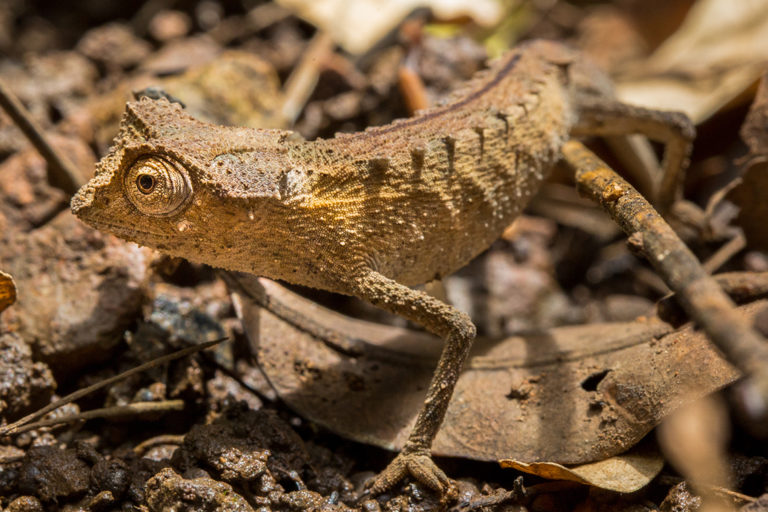 A plated leaf chameleon (Brookesia stumpfii) among the leaf litter of Lokobe National Park. Image © Chris Scarffe Film & Photography/Chris Scarffe.
A plated leaf chameleon (Brookesia stumpfii) among the leaf litter of Lokobe National Park. Image © Chris Scarffe Film & Photography/Chris Scarffe.
Life, and death, as a pet
Even when chameleons are collected under quota, their treatment is a concern for experts. One main reason: CITES export regulations relating to animal welfare are set at the point of export, not capture. Yet collection can be traumatic for chameleons, causing stress, injury and even death.
Deaths usually go unreported, making it difficult to accurately estimate mortality rates of chameleons at any stage of trade. A 2011 report from the U.K.-based NGO TRAFFIC investigating the export of Madagascar’s chameleons to Thailand gives some insight. Interviews with wildlife traders in Thailand revealed that chameleons experienced a higher rate of fatality in transit than other reptiles. Traders frequently reported mortality rates between 10% and 50%, and in some cases all the chameleons in a shipment died during the import process. Another 10% typically died within the first week of arrival in the country.
“Rather than high death rates causing a decline in demand, these reptiles have become thought of as almost disposable and easily replaced,” placing even more pressure on Madagascar’s wild chameleon populations, the report concludes.
The odds don’t improve much for chameleons that survive transit and come to rest in a suburban terrarium. “Out of all the pet reptiles I think that chameleons are one of the least suitable for most pet owners,” says Sean McCormack, a London vet who specializes in the treatment of exotic pets. “They are certainly not suitable for beginners to keep because of their fairly exacting husbandry and nutritional requirements and also because a lot of the species can be really quite stressed by captivity.”
Many first-time buyers don’t know how to recognize signs of stress or illness. Additionally, they often buy cheaper species, for $50 to $150, and tend to decline or put off comparatively expensive veterinary care, McCormack said. “A sick chameleon is often a dead chameleon,” he said: some owners choose to buy a new chameleon rather than care adequately for their existing pet.
For D’Cruze, it’s all part of a bigger problem, where people treat chameleons “as a commodity” at every stage of the wildlife trade and “do not fully appreciate and take into consideration that reptiles are sentient.”
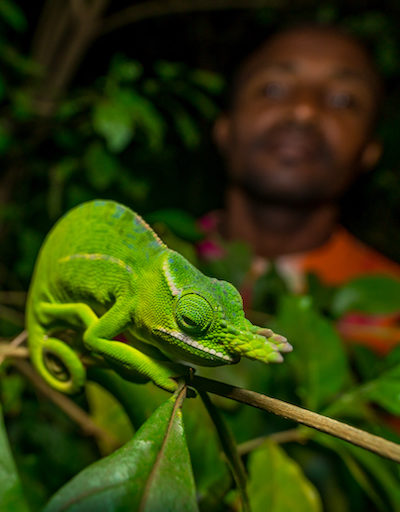 A guide finds a Petter’s Chameleon (Furcifer petteri) in Amber Mountain National Park. Image © Chris Scarffe Film & Photography/Chris Scarffe.
A guide finds a Petter’s Chameleon (Furcifer petteri) in Amber Mountain National Park. Image © Chris Scarffe Film & Photography/Chris Scarffe.
Enforcement trouble
Ivato International Airport is the main gateway into Madagascar, situated on the outskirts of Antananarivo. The vast majority of legally exported chameleons travel through here, with officials checking their CITES papers and quota numbers. The airport is also likely a hub for the country’s illegal wildlife trade, including chameleons, according to Griffiths. “So there is a pinch point there, and to my mind if that could be nailed shut then you can stop a lot of the issues,” he said.
Preventing the illegal export of chameleons via the airport is no simple task without improvements in technology, according to workers there. “The issue we have is that our scanner is not a biological scanner and the one we have does not detect animals well,” said Parany Rabemanontany, head of the Forestry Control Service at Ivato airport. “For example, if you just have one or two small chameleons, it’s very hard to spot them on the scanner. This is why it’s very important to thoroughly hand-check passengers’ luggage and clothing.”
Despite these checks, Rabemanontany said that during the four years he has worked at the airport he only knows of two occasions when people were arrested for attempting to smuggle out chameleons. On both occasions the people were fined and jailed, he said. Yet many other chameleon smugglers surely slip through.
Rabemanontany said Malagasy authorities are working to improve the ability of airport personnel to distinguish between chameleon species so they can better spot protected species traveling under falsified or simply inaccurate export licenses. “We have now been given extensive training and we have identification guides to help us with our work,” he said.
Those measures have not gone far enough, and the problem of insufficient training persists, according to Raphali Andriantsimanarilafy, a biologist with expertise in chameleons at the Malagasy biodiversity organization Madagasikara Voakajy. Andriantsimanarilafy also noted that high airport staff turnover and corruption could potentially compromise progress.
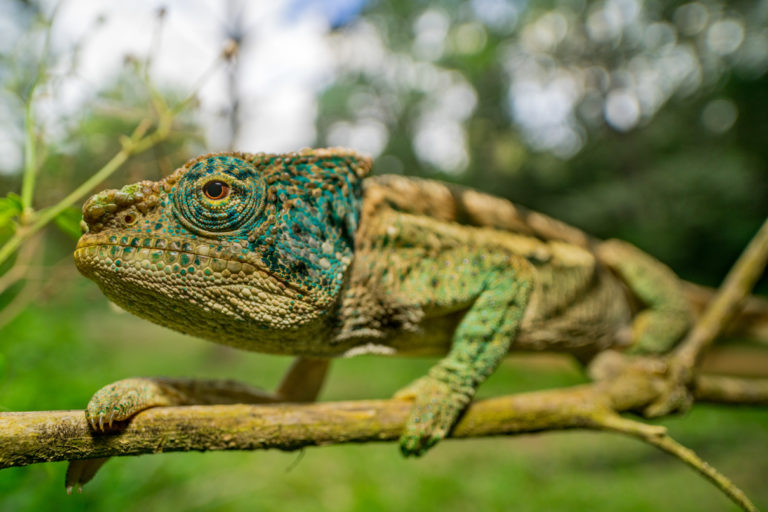 Arthur’s chameleon (Calumma ambreense) in Amber Mountain National Park in northern Madagascar. Image © Chris Scarffe Film & Photography/Chris Scarffe.
Arthur’s chameleon (Calumma ambreense) in Amber Mountain National Park in northern Madagascar. Image © Chris Scarffe Film & Photography/Chris Scarffe.
Improving the pet trade
Some groups, including World Animal Protection, say the trade in wild chameleons is so harmful that all commerce should be stopped except for legitimate research and conservation purposes. Others, such as the chameleon breeder Necas, say a ban would go too far. While acknowledging that the chameleon trade needs to change, he said the unnecessary death and suffering could be dramatically reduced through better regulation, education of owners to provide better care, and perhaps even a licensing system so only experienced hobbyists could keep chameleons.
A blanket ban on commercial trade in wild chameleons would also affect the livelihoods of local legal collectors and conservation efforts, according to Andriantsimanarilafy. “Trade can help the conservation of [chameleon] species and their habitat if there really is transparency and a fair sharing of benefits,” he said.
Currently this is not the case, according to a 2018 study that Andriantsimanarilafy and Griffiths co-authored. It found that reptile and amphibian exporters gained the most: 92% of the final export price, or 57% after deducting their costs. Local collectors received only 1.4% of the final sales price.
“Somehow that economic model needs to be re-evaluated. More money needs to reach the local communities,” Griffiths said. “I think the bottom line is that it has to be more of an incentive than chopping some trees down and putting some rice fields in.”
Captive breeding is one way to supply the pet market and reduce pressure on wild populations, but it has had limited success with chameleons. Only a few species that are consistently available as pets can be bred in captivity.
The Parson’s chameleon (Calumma parsonii) is a case in point. It is one of the largest and most sought-after chameleons among serious hobbyists, and according to Necas the most expensive, with one pair reportedly sold for $14,000. Despite this financial incentive, figuring out how to breed the species has been a “big, big problem,” Necas said. “In the 1990s they exported them to the United States in the tens of thousands and they all died as they couldn’t reproduce.” Thirty years later, only a handful of specialists are successfully breeding Parson’s chameleons, and only in limited numbers.
Pulling out my camera in Lokobe forest to get a last photo, a panther chameleon locked eyes on my lens. Looking back at it through the magnification of my lens, I could see every detail of this evolutionary wonder as it gently swayed, mimicking the movement of a leaf in the late afternoon breeze.
Looking me up and down, the chameleon seemed to be trying to decide whether this human was friend or foe. Given what I had learned, it was an important distinction to make.
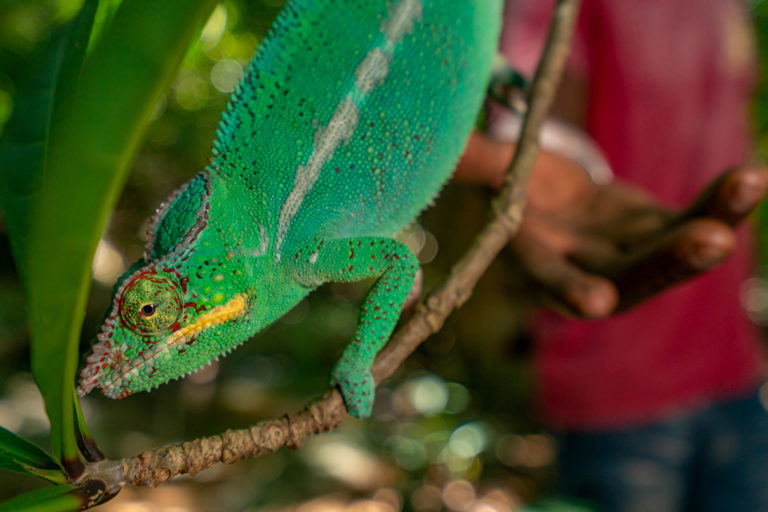 A guide and chameleon trader, named “Jean” in the story, and a panther chameleon in Lokobe National Park. Image © Chris Scarffe Film & Photography/Chris Scarffe.
A guide and chameleon trader, named “Jean” in the story, and a panther chameleon in Lokobe National Park. Image © Chris Scarffe Film & Photography/Chris Scarffe.
Chris Scarffe is an independent filmmaker, photographer and writer who specializes in environmental and wildlife related content. See his work at www.chrisscarffe.com.
Additional reporting by Michel Strogoff.
Clarification 1/23/21: We added a line describing Petr Necas’s affiliation with Bion Terrarium Center in Kyiv, Ukraine.
Citations:
Alfino, S., & Roberts, D. L. (2019). Estimating identification uncertainties in CITES ‘look-alike’ species. Global Ecology and Conservation, 18, e00648. doi:10.1016/j.gecco.2019.e00648
Auliya, M., Altherr, S., Ariano-Sanchez, D., Baard, E. H., Brown, C., Brown, R. M., … Ziegler, T. (2016). Trade in live reptiles, its impact on wild populations, and the role of the European market. Biological Conservation, 204, 103-119. doi:10.1016/j.biocon.2016.05.017
Carpenter, A. I., Marcus Rowcliffe, J., & Watkinson, A. R. (2004). The dynamics of the global trade in chameleons. Biological Conservation, 120(2), 291-301. doi:10.1016/j.biocon.2004.03.002
Gavin, M. C., Solomon, J. N., & Blank, S. G. (2010). Measuring and monitoring illegal use of natural resources. Conservation Biology, 24(1), 89-100. doi:10.1111/j.1523-1739.2009.01387.x
Lambert, Carder, & D’Cruze. (2019). Given the cold shoulder: A review of the scientific literature for evidence of reptile sentience. Animals, 9(10), 821. doi:10.3390/ani9100821
Robinson, J. E., Griffiths, R. A., St. John, F. A., & Roberts, D. L. (2015). Dynamics of the global trade in live reptiles: Shifting trends in production and consequences for sustainability. Biological Conservation, 184, 42-50. doi:10.1016/j.biocon.2014.12.019
Robinson, J. E., Griffiths, R. A., Fraser, I. M., Raharimalala, J., Roberts, D. L., & St. John, F. A. (2018). Supplying the wildlife trade as a livelihood strategy in a biodiversity hotspot. Ecology and Society, 23(1). doi:10.5751/es-09821-230113
Robinson, J. E., Fraser, I. M., St. John, F. A., Randrianantoandro, J. C., Andriantsimanarilafy, R. R., Razafimanahaka, J. H., … Roberts, D. L. (2018). Wildlife supply chains in Madagascar from local collection to global export. Biological Conservation, 226, 144-152. doi:10.1016/j.biocon.2018.07.027
FEEDBACK: Use this form to send a message to the editor of this post. If you want to post a public comment, you can do that at the bottom of the page.
Animal Behavior, Animal Welfare, Animals, Archive, Biodiversity, Charismatic Animals, Cites, Conservation, Conservation And Poverty, Developing Countries, Endangered Species, Environment, Environmental Law, Featured, Governance, Green, Habitat, Habitat Destruction, Herps, International Trade, Law Enforcement, Pet Trade, Pets, Poverty, Reptiles, Science, Species, Wildlife, Wildlife Conservation, Wildlife Trade
Africa, East Africa, Madagascar
Source link : https://news.mongabay.com/2021/01/pet-trade-relies-on-disposable-wild-chameleons-from-madagascar/
Author :
Publish date : 2021-01-20 08:00:00
Copyright for syndicated content belongs to the linked Source.






